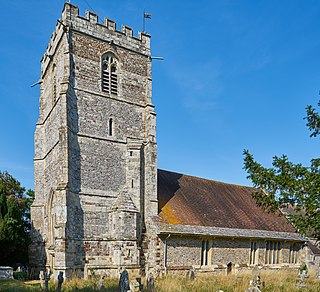Related Research Articles

An abbey is a type of monastery used by members of a religious order under the governance of an abbot or abbess. Abbeys provide a complex of buildings and land for religious activities, work, and housing of Christian monks and nuns.

The Benedictines, officially the Order of Saint Benedict, are a monastic religious order of the Catholic Church following the Rule of Saint Benedict. They are also sometimes called the Black Monks, in reference to the colour of their religious habits. They were founded by Benedict of Nursia, a 6th-century monk who laid the foundations of Benedictine monasticism through the formulation of his Rule of Saint Benedict.

Westminster Abbey, formally titled the Collegiate Church of Saint Peter at Westminster, is a large, mainly Gothic abbey church in the City of Westminster, London, England, just to the west of the Palace of Westminster. It is one of the United Kingdom's most notable religious buildings and the traditional place of coronation and a burial site for English and, later, British monarchs.

Malmesbury Abbey, at Malmesbury in Wiltshire, England, is a religious house dedicated to Saint Peter and Saint Paul. It was one of the few English houses with a continuous history from the 7th century through to the Dissolution of the Monasteries.

Whitby Abbey was a 7th-century Christian monastery that later became a Benedictine abbey. The abbey church was situated overlooking the North Sea on the East Cliff above Whitby in North Yorkshire, England, a centre of the medieval Northumbrian kingdom. The abbey and its possessions were confiscated by the crown under Henry VIII during the Dissolution of the Monasteries between 1536 and 1545.

Winchcombe Abbey is a now-vanished Benedictine abbey in Winchcombe, Gloucestershire; this abbey was once in the heart of Mercia, an Anglo Saxon kingdom at the time of the Heptarchy in England. The Abbey was founded c. 798 for three hundred Benedictine monks, by King Offa of Mercia or King Coenwulf of Mercia. In its time, it was the burial place of two members of the Mercian ruling class, the aforementioned Coenwulf and his son Cynehelm, later venerated as Saint Kenelm.

Humberston is a village and civil parish south of Cleethorpes in North East Lincolnshire, England.

Pluscarden Abbey is a Roman Catholic Benedictine monastery in the glen of the Black Burn, 6 miles south-west of Elgin, Moray, Scotland. It was founded in 1230 by Alexander II for the Valliscaulian Order.
Folkestone Priory was a pre-Reformation Benedictine monastery at Folkestone in the English county of Kent. The priory church survives as the present parish church. It was the successor to Folkestone Abbey, an Anglo-Saxon nunnery on a different site.

Thorney Abbey, now the Church of St Mary and St Botolph, was a medieval monastic house established on the island of Thorney in The Fens of Cambridgeshire, England.

Solesmes Abbey or St. Peter's Abbey, Solesmes is a Benedictine monastery in Solesmes, famous as the source of the restoration of Benedictine monastic life in the country under Dom Prosper Guéranger after the French Revolution. The current abbot is the Right Reverend Dom Philippe Dupont, O.S.B.

Saint Mildrith, also Mildthryth, Mildryth and Mildred,, was a 7th and 8th-century Anglo-Saxon abbess of the Abbey at Minster-in-Thanet, Kent. She was declared a saint after her death, and later her remains were moved to Canterbury.

Gloucester Abbey was a Benedictine abbey in the city of Gloucester, England. Since 1541 it has been Gloucester Cathedral.
St. Mary's Abbey, also known as the Nunnaminster, was a Benedictine nunnery in Winchester, Hampshire, England. It was founded between 899 and 902 by Alfred the Great's widow Ealhswith, who was described as the 'builder' of the Nunnaminster in the New Minster Liber Vitae. The first buildings were completed by their son, Edward the Elder. Among the house's early members was Edward's daughter Edburga.

Cranborne Priory was a priory in Cranborne in Dorset, England. The priory church survives as Cranborne's parish church, the Church of St Mary and St Bartholomew, and is a Grade I listed building, with parts of the building dating back to the 12th century.

Deeping St James Priory was a priory in Deeping St James, Lincolnshire, England. In 1139 Baldwin Fitz Gilbert established the Benedictine Priory of Saint James at Deeping as a cell of Thorney Abbey. The cell was dissolved at the surrender of Thorney in 1539. The priory church remains as the Church of England parish church of Deeping St James and is a Grade I listed building.

Kyme Priory was a priory in South Kyme, Lincolnshire, England. What remains of the buildings are now part of Saint Mary and All Saints Church.

St. Mary Magdalen was a Benedictine priory in Lincoln, England. Along with Sandtoft Priory and Hanes Cell, it was a Lincolnshire cell of St Mary's Abbey in York, England. A surviving building, once owned by the priory, is Monks' Abbey, Lincoln.

Rosedale Priory was a priory in Rosedale Abbey, North Yorkshire, England that was founded c. 1150–1199. By the time the priory was suppressed in 1535, it had one prioress and eight nuns. The religious house in Rosedale was a priory and not an abbey, despite the village being given the name Rosedale Abbey, and it is unclear why this came about.
Sele Priory was a medieval monastic house in Upper Beeding, West Sussex, England.
References
- ↑ "Humberston Abbey". Houses of Benedictine of the Order of Tiron. Victoria County History. Retrieved 4 August 2011.
- ↑ Historic England. "Humberston Abbey (81877)". Research records (formerly PastScape). Retrieved 4 August 2011.
Coordinates: 53°32′03″N0°01′33″W / 53.53406°N 0.02596°W

